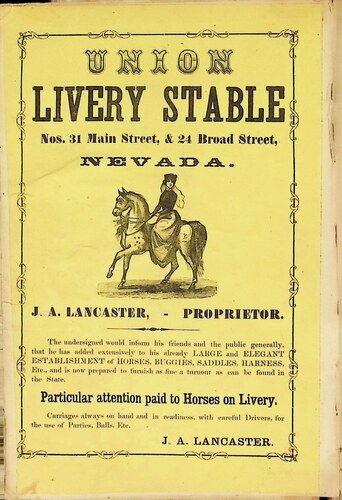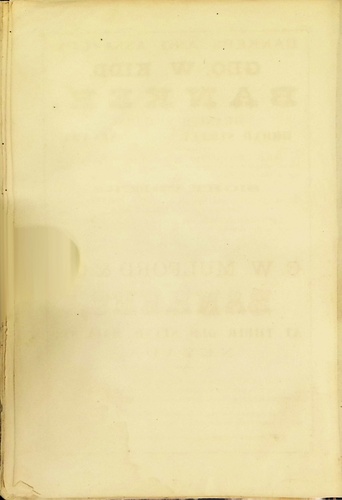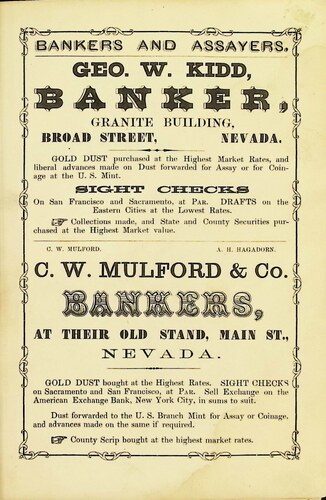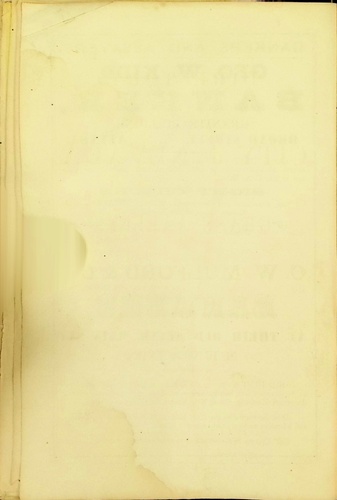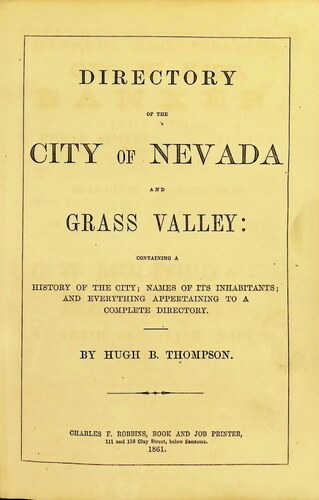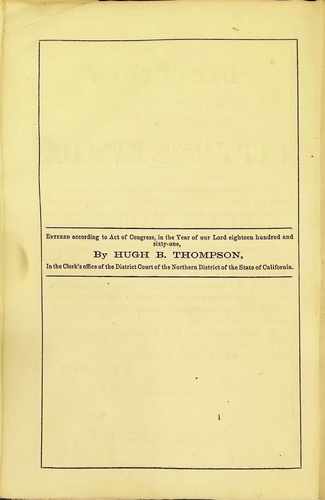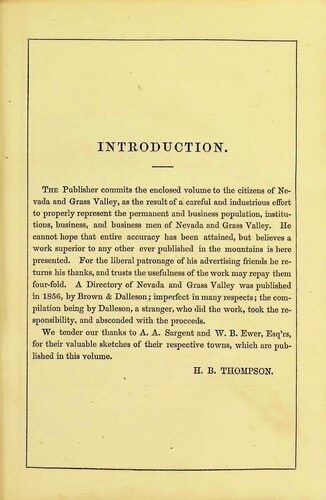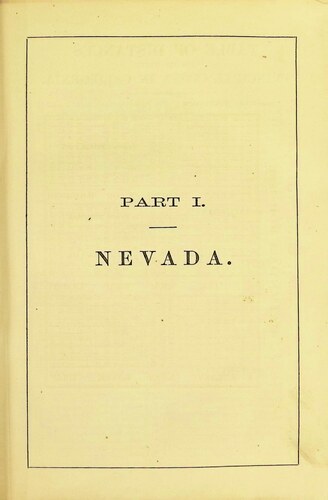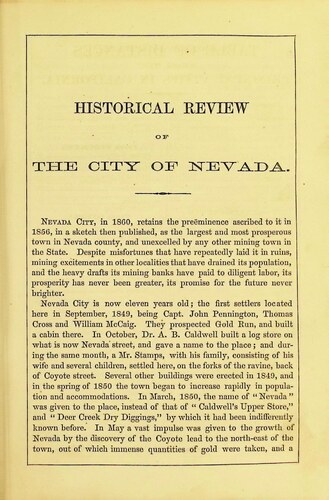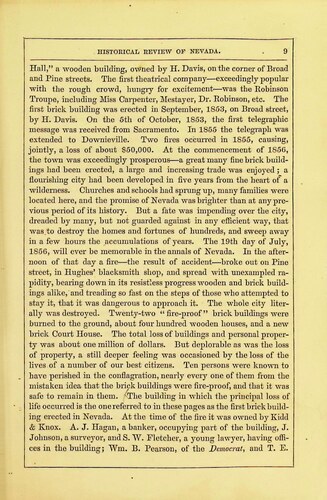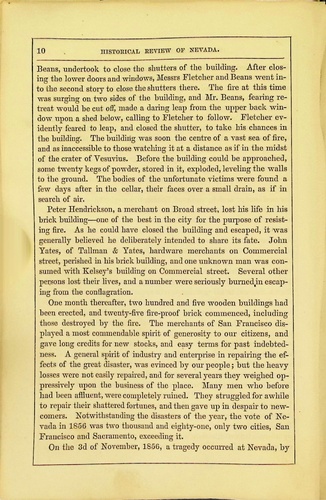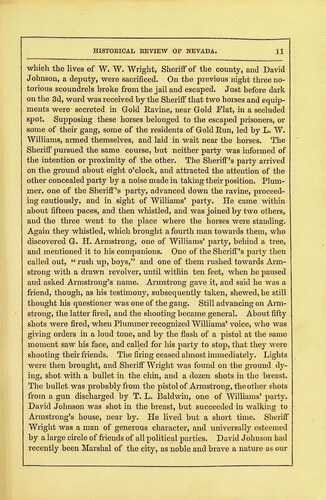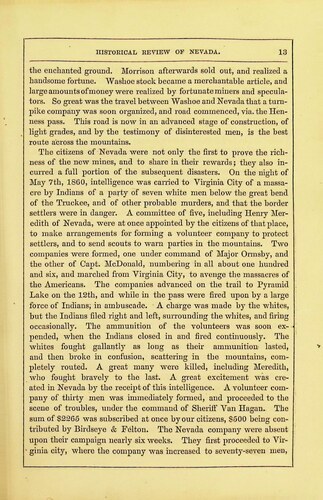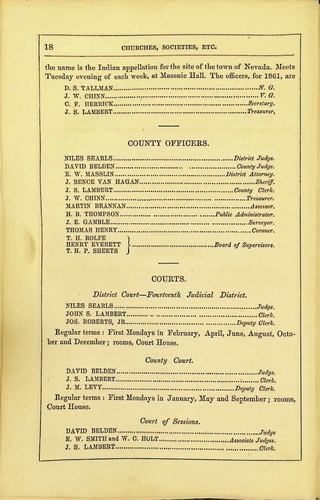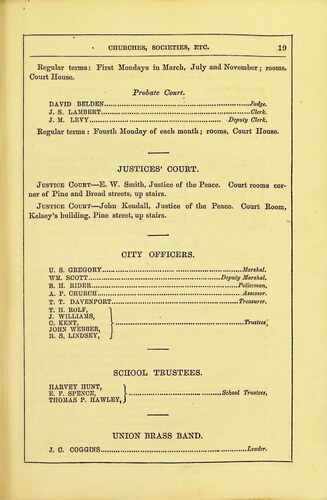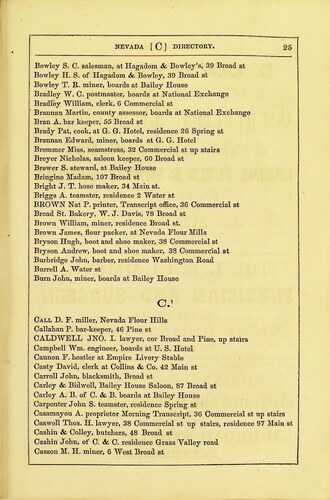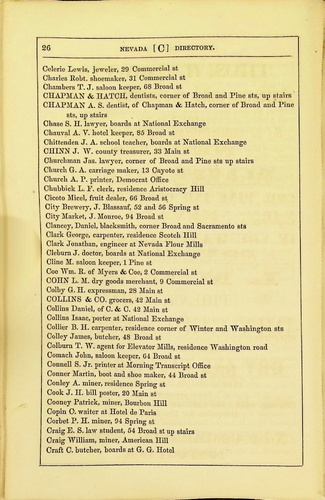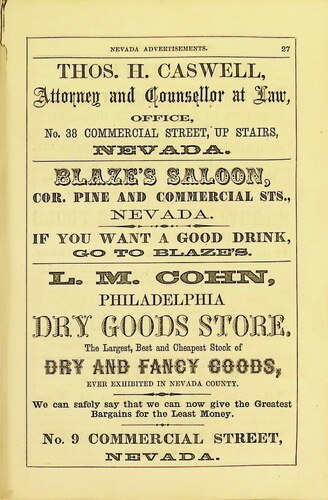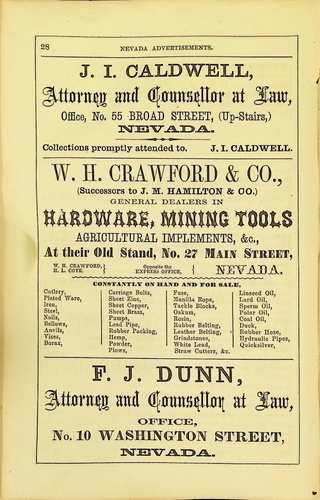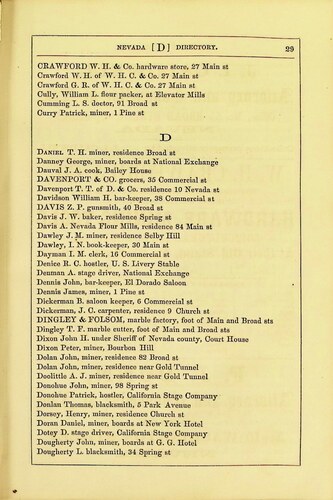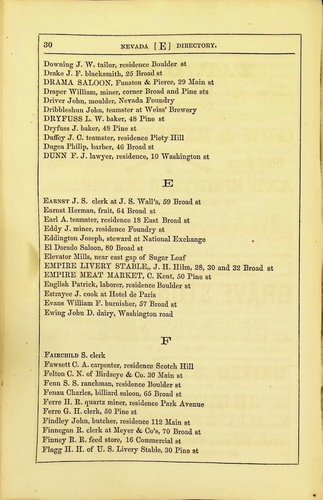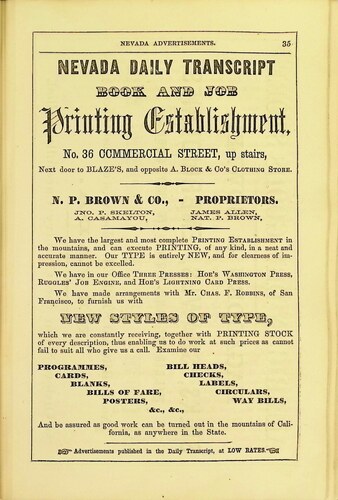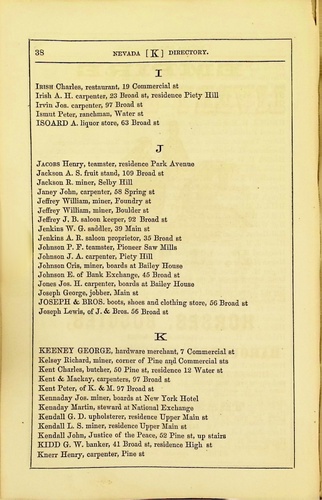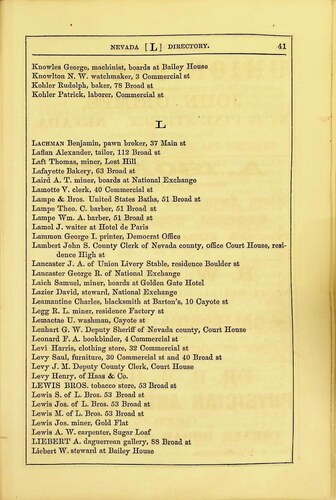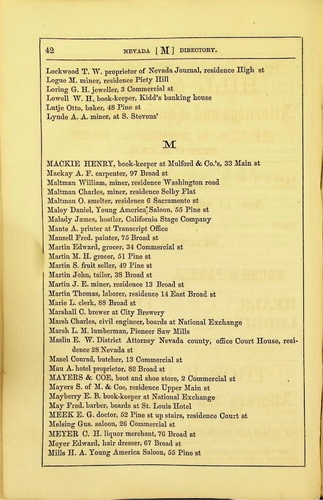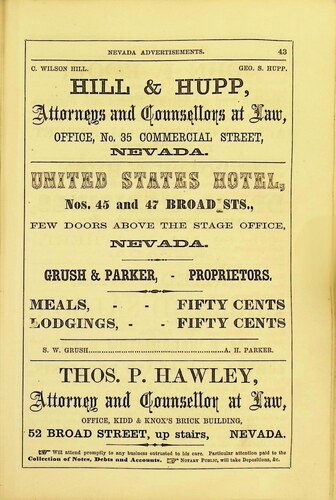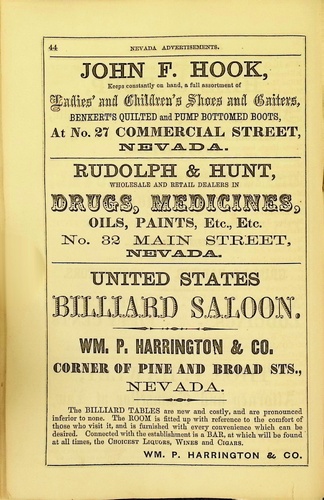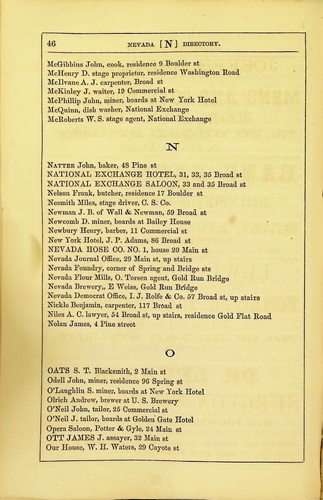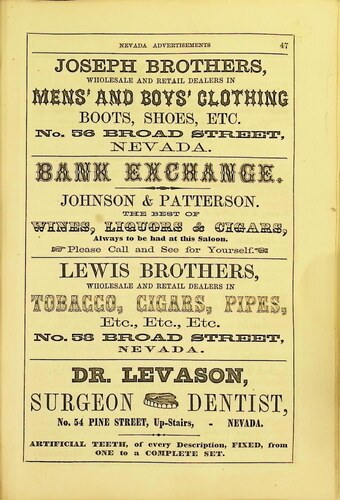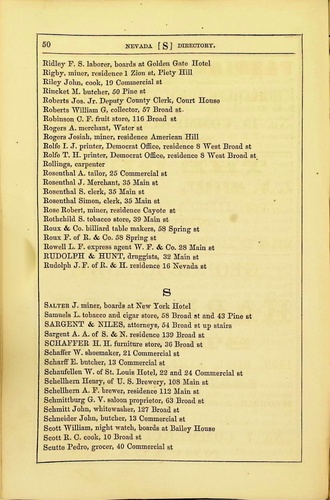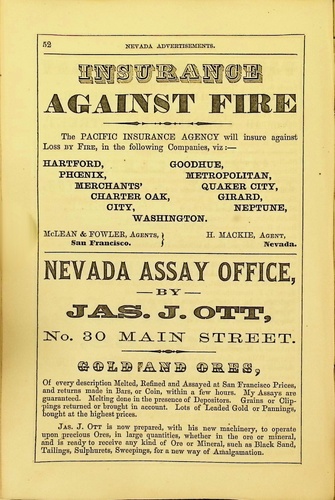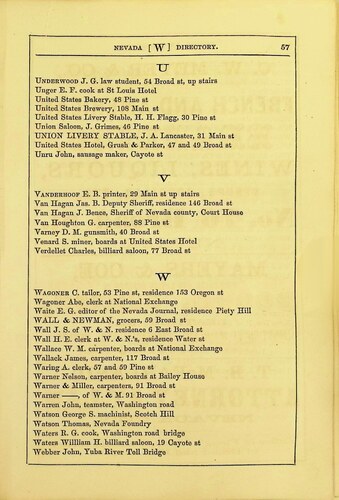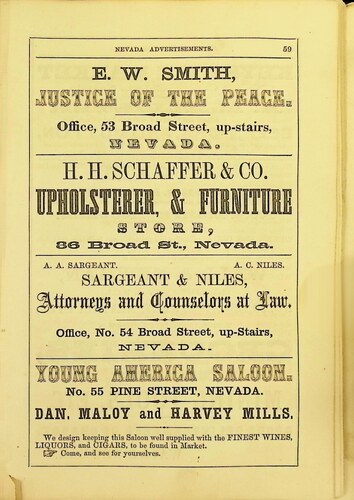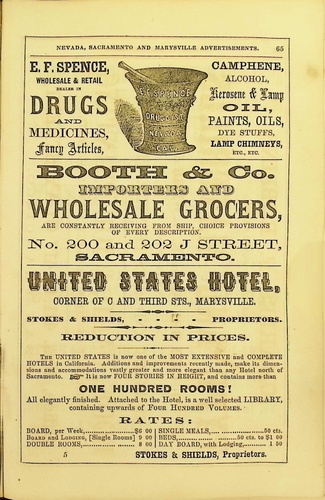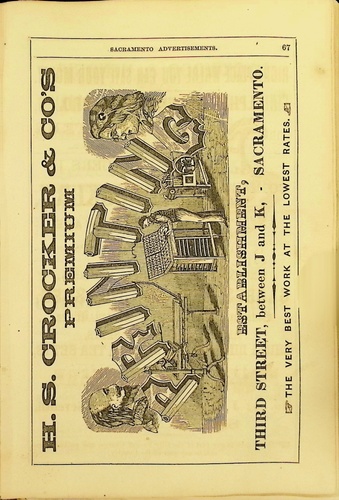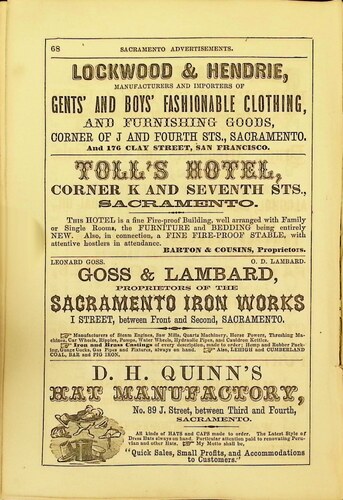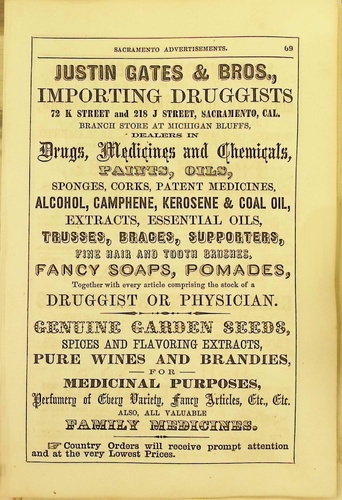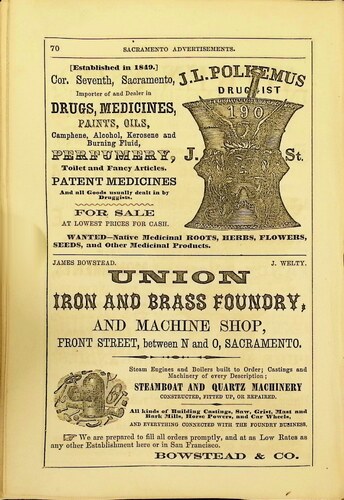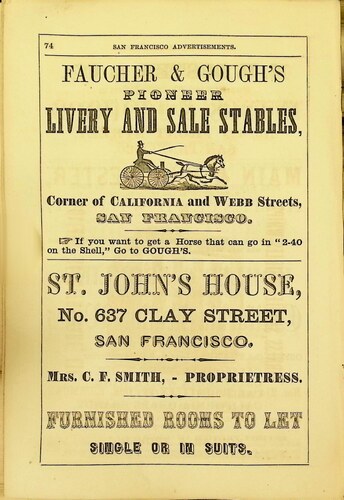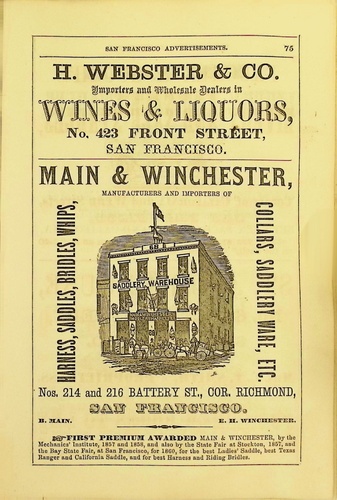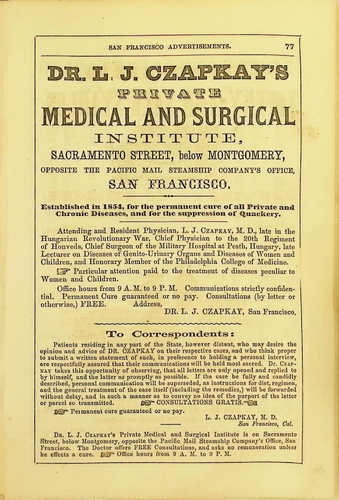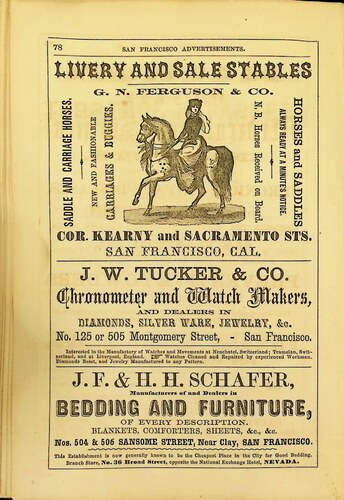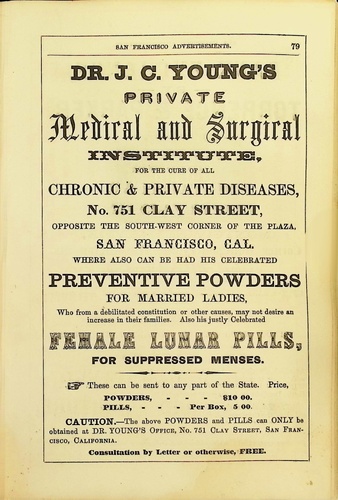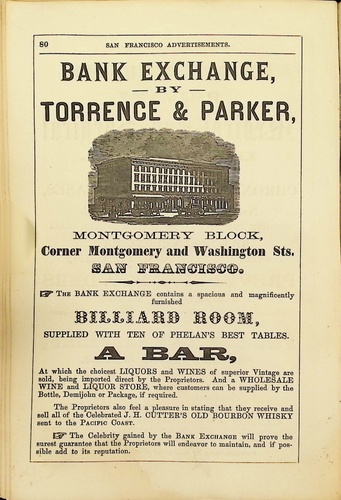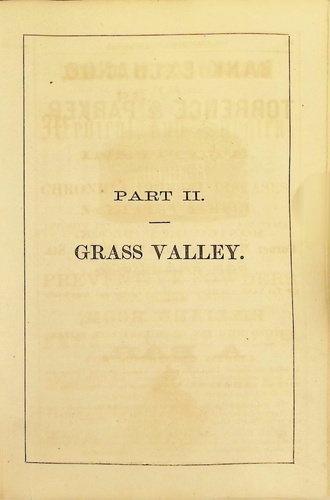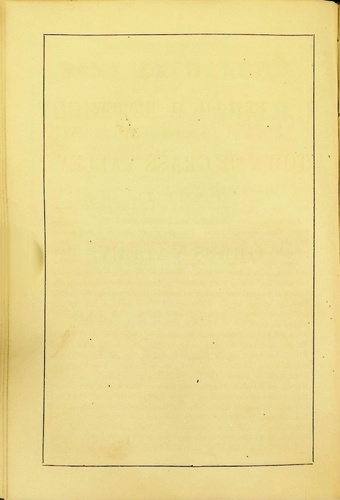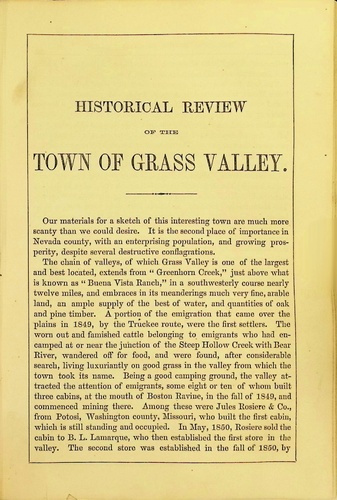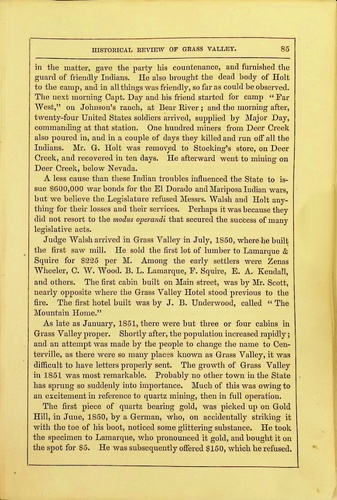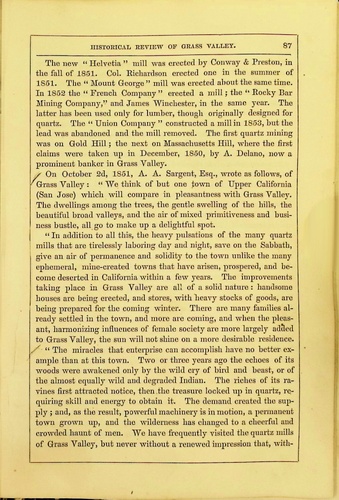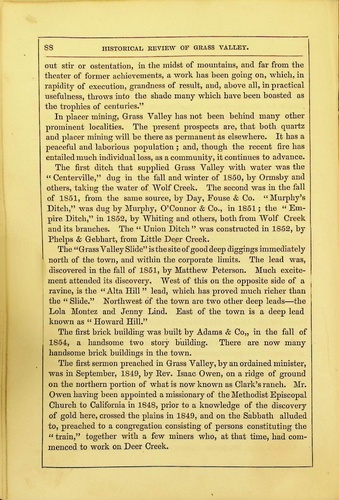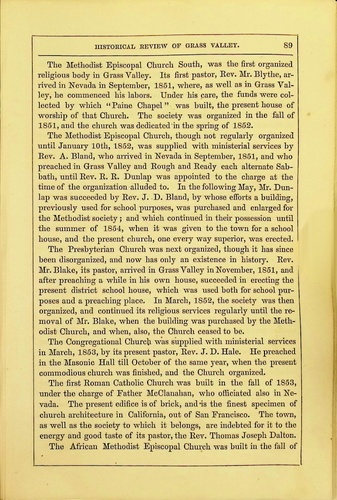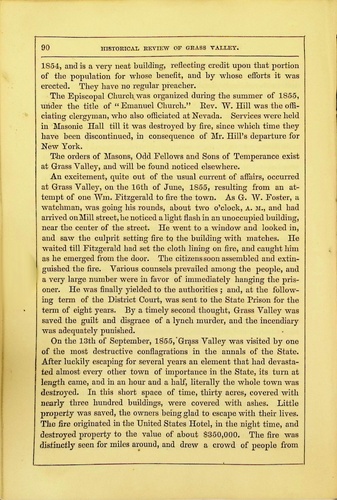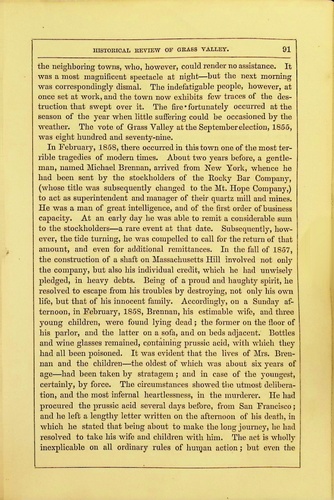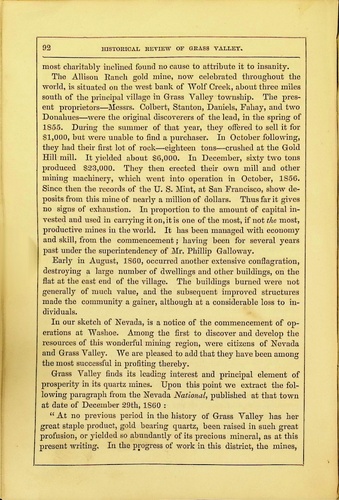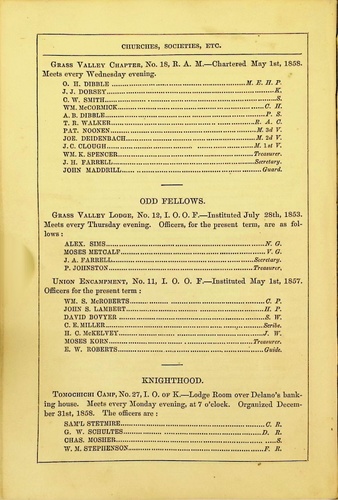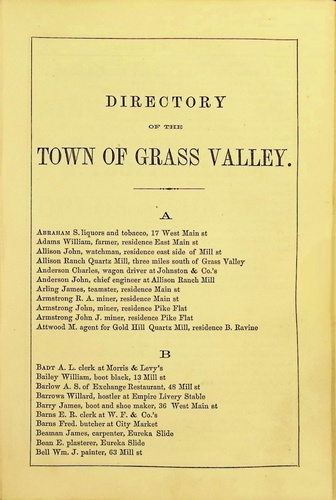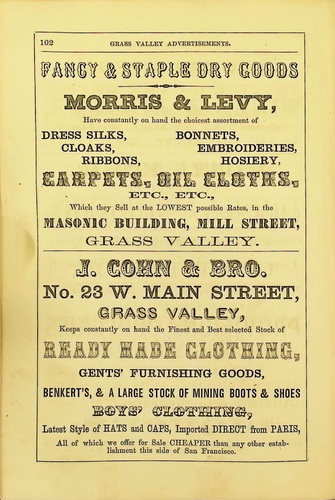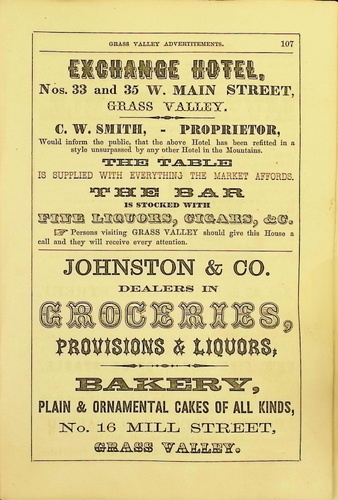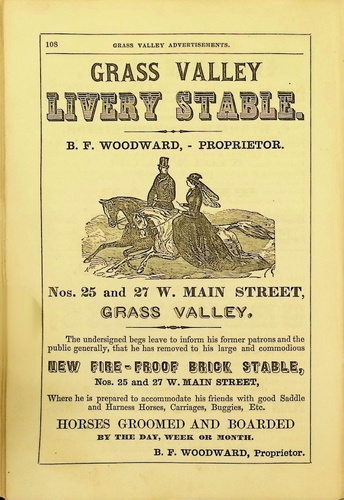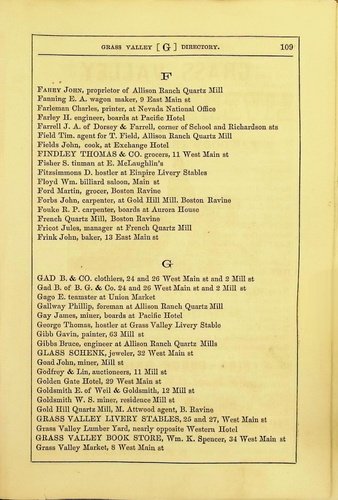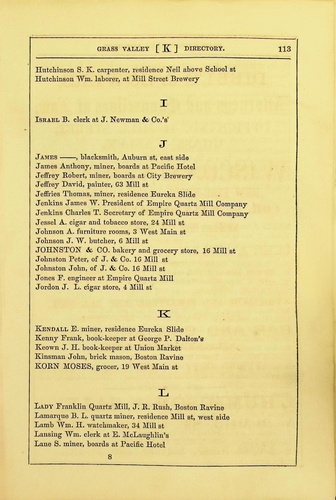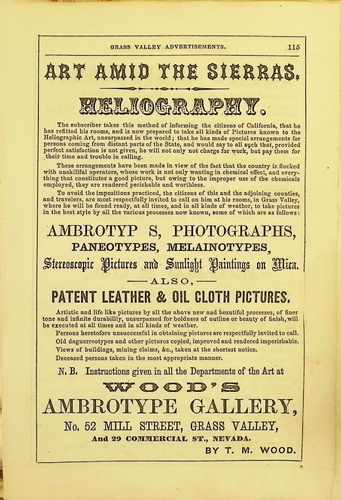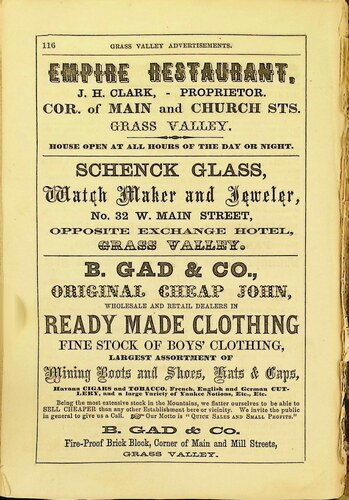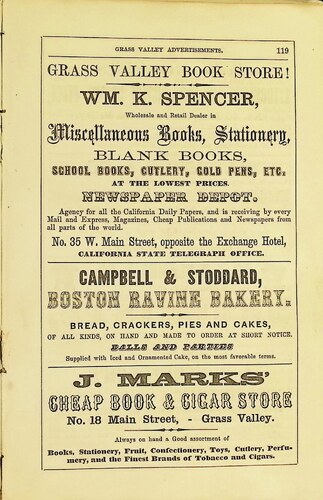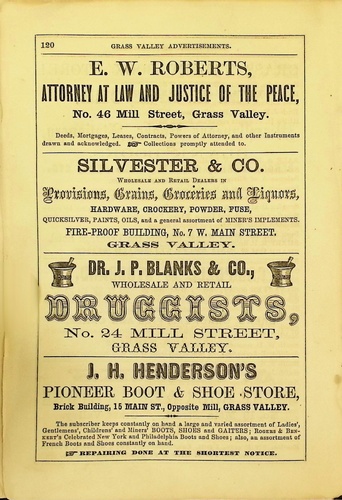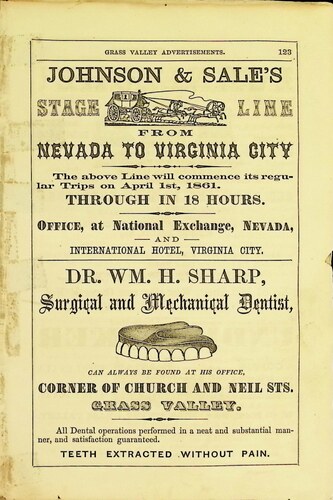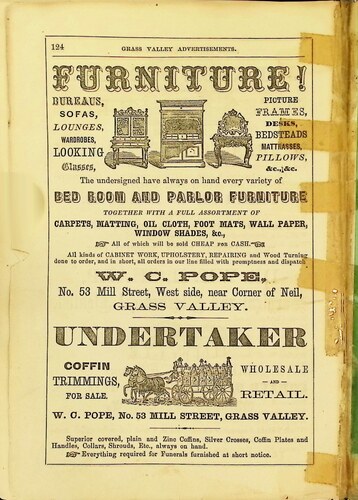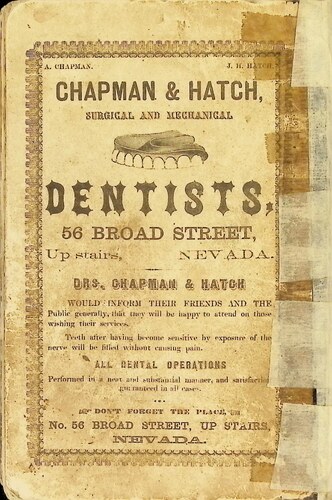Enter a name, company, place or keywords to search across this item. Then click "Search" (or hit Enter).
Collection: Directories and Documents > Directories
Directory of the City of Nevada and Grass Valley (650.025.THO)(1861) (132 pages)
Flawed it is, as are all directories. And attacked it was by some newspapers the first week of its publication. But "worthless" Thompson's 1861 Directory of the City of Nevada and Grass Valley is not.
The directory's subtitle -- "Containing a history of the city; names of its inhabitants; and everything appertaining to a complete directory" -- betrays its focus on the "city" of Nevada versus the "town" of Grass Valley. Hugh B. Thompson (1818-1865) -- like Brown & Dallison in their making of the 1856 Directory of Nevada, Grass Valley and Rough and Ready -- saw Nevada, then the most populous town in Nevada County, and its seat, as more important.
Thompson claimed Brown & Dallison's directory was "imperfect in many respects; the compilation being by Dallison, a stranger, who did the work, took the responsibility, and absconded with the proceeds" (Directory, Introduction, p3). However, The Nevada Journal found the material and some spellings in Thompson's directory wanting. The unsigned writer, Edwin Giles Waite (1824-1894), the Journal's publisher, denounced Aaron Sargent's sketch of James Ott's role in the 1859 discovery of the Comstock Lode in western Utah Territory (Directory, Historical Review of the City of Nevada, pp12-13) and gave his own account (Journal, Friday, 1 March 1861, p3).
The Nevada Democrat had earlier reported its receipt of an advance copy of the directory and averred that it statistics were "evidently compiled with great care" (Tuesday, 26 February 1861, p3). But following Waite's broadside, it retracted its "compiled with great care" comment and humorously declared the directory "worthless" -- because its list of Nevada officers had dropped the "e" in the name of T. H. Rolfe, a town trustee, and also a Democrat editor (The Nevada Democrat, Saturday, 2 March 1861, p3). Elsewhere the directory correctly rendered the family name of the Democrat's printers -- I. J. Rolfe (Ianthus Jerome Rolfe, 1926-1907), and his younger brother T. H. Rolfe (Tallman Hathaway Rolfe, 1824-1874).
Thompson, in a card placed in The Morning Transcript, took responsibility for errors that were his, argued that a few errors in such directories are inevitable, and otherwise stood by the value of his work. He also reported that he had provided Sargent with Ott's story, which he had obtained in writing directly from Ott. And surely Ott was more reliable than the likes of Mr. Waite, for whose opinions Thompson believed that Sargent , "in common with everyone who really knows E. G. Waite, has an utter contempt" (Transcript, Monday, 4 March 1861, p3).
Compilation -- Thompson began compiling his directory in November 1860 by numbering the buildings of Nevada, then numbering Grass Valley. In December he solicited advertising, and in late February 1861 he presented a copy to The Nevada Democrat in advance of its release in March.
Listings -- The directory's 1,191 address listings include 736 (61.8 percent) for Nevada but only 455 (38.2 percent) for Grass Valley. Some 55.2 percent (406) of Nevada's listings, but only 31.4 percent (143) of Grass Valley's listings, had building numbers. While Grass Valley got 10 times more space relative to Nevada than it did in Brown & Dallison's 1856 directory, it still had over 36 percent fewer listings proportional to the 1860 census populations for the two townships, nearly equal at 4,040 for Nevada and 3,940 for Grass Valley. (Census populations per The Nevada National, Wednesday, 29 August 1860, p2; all other figures and percents tallied and computed by this reviewer.)
Building numbers -- The building numbers appear to have been assigned -- or reassigned or simply confirmed -- according to the scheme used by Dallison when numbering Nevada in the fall of 1855, and the system used by someone known only as "Hombre" when numbering Grass Valley in the spring of 1856 -- too late for the Brown & Dallison directory. Whatever the explanation for the disproportionately fewer Grass Valley listings in Thompson's directory, the listings are important because they constitute the earliest record of numbered street addresses in Grass Valley, other than in a smattering of newspaper ads.
Nevada's Main street had even numbers on its right (east) side, and odd numbers on its left (north) side, beginning from its head coming off the Main street bridge over Deer Creek from the plaza. By early 1883, Main street in Nevada City was renumbered with odd numbers on the right and even on the left. The present system, with even numbers again on the right, was adopted in 1905.
Grass Valley's main street was numbered East and West of Auburn street, odd on the north side and even on the south side, resulting in East Main and West Main distinctions -- 1 West Main on the NW corner of Main and Auburn (Loutzenheiser's apothecary shop), 1 East Main on the NE corner, 2 East Main on the SE corner, and 2 West Main on SW corner. By early 1867, Main was renumbered from the start of Main street off the Nevada Road, at the corporate boundary between Bennett and Eureka streets -- even up the right (north) side and odd up the left (south) side -- hence no East/West distinctions. 1 East Main became 66 Main, while 1 West Main became 68 Main (Loutzenheiser's). Then an early 1905 Grass Valley building number ordinance re-established Auburn street as the baseline for Main street, but it kept the odd south, even north scheme, hence 66 Main became 2 East Main while 68 Main became 68 Main became 2 West Main (Loutzenheiser's).
Thomson during the rebellion
In October 1861, six months into the rebellion of the Confederacy against the Union, Hugh B. Thompson vanished. He was rumored to have skipped town for Mexico with from hundreds to thousands of dollars of money from several estates, entrusted to him in his capacity as Nevada County Public Administrator. The Nevada Journal reported that he managed to become an administrator despite his reputation as "an inveterate gambler and whiskey sucker" and "a notorious defaulter" (The Nevada Journal, Friday, 11 October 1861, p2).
Local papers couldn't resist bar humor. The Morning Transcript reported that a man at Blaze's Saloon on the corner of Commercial and Pine whispered in Blaze's ear, "Is it true that Thompson has left?" "It is," Blaze replied. "Is he much behind?" the man said. "No, he is ahead," Blaze said. The man immediately called up all hands (The Morning Transcript, Thursday, 18 October 1861, p3).
The Transcript averred that the true reason Thompson left was to look after Phil Moore, a deputy tax collector who had also made a hasty departure, with money that belonged to the county. The writer, in the sort of undisguised sarcasm that was common in editorials at the time, described Moore's and Thompson's "taking French leave" capers like this (The Morning Transcript, Friday, 1 November 1861, p3).
Moore did not leave to avoid the friends who had trusted him. He
left to raise a subscription fund intended to buy shrimps for the
Southern Army. Hugh Thompson did not go to Mexico to avoid the bore
of settling his own accounts ; he went to look after his friend
Phil. Moore, and he only took that roundabout way to avoid stage
traveling through a wild sage country, the scenery of Mexico, with
its mezquite groves and senoritas, being much more pleasant.
A month after Thompson fled, the Probate Court of Nevada County published a notice ordering him to appear in court to show cause why the letters of administration issued him by the court, regarding the estates of the 7 men and 1 woman listed in the notice, should not be revoked (The Nevada Democrat, Saturday, 2 November 1861, p2). The notice was pro forma, issued only to comply with legal procedures in such cases. But given that Thompson was unlikely to see the notice, much less comply, it was also akin to an official allegation that he had failed to fulfill his duties as a public administrator.
Half a year later, Thompson became the butt of some "spotting" humor. A local man, hearing a rumor that Thompson was back in town, "scoured the town to find the long-lost, but without avail. He visited the gambling-room, the saloon, and other places, and finally the grave-yard, but no Thompson could be seen" (The Morning Transcript, Wednesday, 12 March 1862, p3).
A year and half after Thompson disappeared, a Nevadan traveling through Mexico reported running into him, and said that Thompson "is going to pay up if he every gets enough ahead" (The Morning Transcript, Wednesday, 18 March 1863, p3).
A Washington Territory paper reported that a Hugh B. Thompson, aged 47 years, formerly of Dubuque, Iowa, had died on 22 August 1865 after a lingering illness, at his mother's home near Walla Walla (Walla Walla Statesmen, Friday, 25 August 1865, p2). A month later, The Daily Bee in Sacramento carried a similar notice (Friday, 22 September, 1865). Two days after the Bee report, Nevada Daily Transcript carried the following brief (Sunday, 24 September 1865, p3).
An Old Nevadan Gone. -- We notice in the Sacramento Union a record of
the death of Hugh B. Thompson. He died of a lingering illness at
Walla Walla, Washington Territory. Thompson went from this place to
Mexico, and as the notice of his death states that he was formerly of
Dubuque, Ia., we think there is but little doubt as to its being
Hugh B. Thompson, formerly Public Administrator of this county.
The directory's subtitle -- "Containing a history of the city; names of its inhabitants; and everything appertaining to a complete directory" -- betrays its focus on the "city" of Nevada versus the "town" of Grass Valley. Hugh B. Thompson (1818-1865) -- like Brown & Dallison in their making of the 1856 Directory of Nevada, Grass Valley and Rough and Ready -- saw Nevada, then the most populous town in Nevada County, and its seat, as more important.
Thompson claimed Brown & Dallison's directory was "imperfect in many respects; the compilation being by Dallison, a stranger, who did the work, took the responsibility, and absconded with the proceeds" (Directory, Introduction, p3). However, The Nevada Journal found the material and some spellings in Thompson's directory wanting. The unsigned writer, Edwin Giles Waite (1824-1894), the Journal's publisher, denounced Aaron Sargent's sketch of James Ott's role in the 1859 discovery of the Comstock Lode in western Utah Territory (Directory, Historical Review of the City of Nevada, pp12-13) and gave his own account (Journal, Friday, 1 March 1861, p3).
The Nevada Democrat had earlier reported its receipt of an advance copy of the directory and averred that it statistics were "evidently compiled with great care" (Tuesday, 26 February 1861, p3). But following Waite's broadside, it retracted its "compiled with great care" comment and humorously declared the directory "worthless" -- because its list of Nevada officers had dropped the "e" in the name of T. H. Rolfe, a town trustee, and also a Democrat editor (The Nevada Democrat, Saturday, 2 March 1861, p3). Elsewhere the directory correctly rendered the family name of the Democrat's printers -- I. J. Rolfe (Ianthus Jerome Rolfe, 1926-1907), and his younger brother T. H. Rolfe (Tallman Hathaway Rolfe, 1824-1874).
Thompson, in a card placed in The Morning Transcript, took responsibility for errors that were his, argued that a few errors in such directories are inevitable, and otherwise stood by the value of his work. He also reported that he had provided Sargent with Ott's story, which he had obtained in writing directly from Ott. And surely Ott was more reliable than the likes of Mr. Waite, for whose opinions Thompson believed that Sargent , "in common with everyone who really knows E. G. Waite, has an utter contempt" (Transcript, Monday, 4 March 1861, p3).
Compilation -- Thompson began compiling his directory in November 1860 by numbering the buildings of Nevada, then numbering Grass Valley. In December he solicited advertising, and in late February 1861 he presented a copy to The Nevada Democrat in advance of its release in March.
Listings -- The directory's 1,191 address listings include 736 (61.8 percent) for Nevada but only 455 (38.2 percent) for Grass Valley. Some 55.2 percent (406) of Nevada's listings, but only 31.4 percent (143) of Grass Valley's listings, had building numbers. While Grass Valley got 10 times more space relative to Nevada than it did in Brown & Dallison's 1856 directory, it still had over 36 percent fewer listings proportional to the 1860 census populations for the two townships, nearly equal at 4,040 for Nevada and 3,940 for Grass Valley. (Census populations per The Nevada National, Wednesday, 29 August 1860, p2; all other figures and percents tallied and computed by this reviewer.)
Building numbers -- The building numbers appear to have been assigned -- or reassigned or simply confirmed -- according to the scheme used by Dallison when numbering Nevada in the fall of 1855, and the system used by someone known only as "Hombre" when numbering Grass Valley in the spring of 1856 -- too late for the Brown & Dallison directory. Whatever the explanation for the disproportionately fewer Grass Valley listings in Thompson's directory, the listings are important because they constitute the earliest record of numbered street addresses in Grass Valley, other than in a smattering of newspaper ads.
Nevada's Main street had even numbers on its right (east) side, and odd numbers on its left (north) side, beginning from its head coming off the Main street bridge over Deer Creek from the plaza. By early 1883, Main street in Nevada City was renumbered with odd numbers on the right and even on the left. The present system, with even numbers again on the right, was adopted in 1905.
Grass Valley's main street was numbered East and West of Auburn street, odd on the north side and even on the south side, resulting in East Main and West Main distinctions -- 1 West Main on the NW corner of Main and Auburn (Loutzenheiser's apothecary shop), 1 East Main on the NE corner, 2 East Main on the SE corner, and 2 West Main on SW corner. By early 1867, Main was renumbered from the start of Main street off the Nevada Road, at the corporate boundary between Bennett and Eureka streets -- even up the right (north) side and odd up the left (south) side -- hence no East/West distinctions. 1 East Main became 66 Main, while 1 West Main became 68 Main (Loutzenheiser's). Then an early 1905 Grass Valley building number ordinance re-established Auburn street as the baseline for Main street, but it kept the odd south, even north scheme, hence 66 Main became 2 East Main while 68 Main became 68 Main became 2 West Main (Loutzenheiser's).
Thomson during the rebellion
In October 1861, six months into the rebellion of the Confederacy against the Union, Hugh B. Thompson vanished. He was rumored to have skipped town for Mexico with from hundreds to thousands of dollars of money from several estates, entrusted to him in his capacity as Nevada County Public Administrator. The Nevada Journal reported that he managed to become an administrator despite his reputation as "an inveterate gambler and whiskey sucker" and "a notorious defaulter" (The Nevada Journal, Friday, 11 October 1861, p2).
Local papers couldn't resist bar humor. The Morning Transcript reported that a man at Blaze's Saloon on the corner of Commercial and Pine whispered in Blaze's ear, "Is it true that Thompson has left?" "It is," Blaze replied. "Is he much behind?" the man said. "No, he is ahead," Blaze said. The man immediately called up all hands (The Morning Transcript, Thursday, 18 October 1861, p3).
The Transcript averred that the true reason Thompson left was to look after Phil Moore, a deputy tax collector who had also made a hasty departure, with money that belonged to the county. The writer, in the sort of undisguised sarcasm that was common in editorials at the time, described Moore's and Thompson's "taking French leave" capers like this (The Morning Transcript, Friday, 1 November 1861, p3).
Moore did not leave to avoid the friends who had trusted him. He
left to raise a subscription fund intended to buy shrimps for the
Southern Army. Hugh Thompson did not go to Mexico to avoid the bore
of settling his own accounts ; he went to look after his friend
Phil. Moore, and he only took that roundabout way to avoid stage
traveling through a wild sage country, the scenery of Mexico, with
its mezquite groves and senoritas, being much more pleasant.
A month after Thompson fled, the Probate Court of Nevada County published a notice ordering him to appear in court to show cause why the letters of administration issued him by the court, regarding the estates of the 7 men and 1 woman listed in the notice, should not be revoked (The Nevada Democrat, Saturday, 2 November 1861, p2). The notice was pro forma, issued only to comply with legal procedures in such cases. But given that Thompson was unlikely to see the notice, much less comply, it was also akin to an official allegation that he had failed to fulfill his duties as a public administrator.
Half a year later, Thompson became the butt of some "spotting" humor. A local man, hearing a rumor that Thompson was back in town, "scoured the town to find the long-lost, but without avail. He visited the gambling-room, the saloon, and other places, and finally the grave-yard, but no Thompson could be seen" (The Morning Transcript, Wednesday, 12 March 1862, p3).
A year and half after Thompson disappeared, a Nevadan traveling through Mexico reported running into him, and said that Thompson "is going to pay up if he every gets enough ahead" (The Morning Transcript, Wednesday, 18 March 1863, p3).
A Washington Territory paper reported that a Hugh B. Thompson, aged 47 years, formerly of Dubuque, Iowa, had died on 22 August 1865 after a lingering illness, at his mother's home near Walla Walla (Walla Walla Statesmen, Friday, 25 August 1865, p2). A month later, The Daily Bee in Sacramento carried a similar notice (Friday, 22 September, 1865). Two days after the Bee report, Nevada Daily Transcript carried the following brief (Sunday, 24 September 1865, p3).
An Old Nevadan Gone. -- We notice in the Sacramento Union a record of
the death of Hugh B. Thompson. He died of a lingering illness at
Walla Walla, Washington Territory. Thompson went from this place to
Mexico, and as the notice of his death states that he was formerly of
Dubuque, Ia., we think there is but little doubt as to its being
Hugh B. Thompson, formerly Public Administrator of this county.
Catalog #: 650.025.THO
Author: Hugh B. Thompson
Publisher: San Francisco (CA): Charles F. Robbins, Book and Job Printer
Published: 1861
Subjects: Directory, Nevada, City Of Nevada, Grass Valley, 1861, Hugh B. Thompson, E. G. Waite, Phil Moore, J. J. Ott, Comstock Lode, Utah Territory, Territory Of Utah, N. P. Brown, J. K. Dallison
Related Items: Original Held At:
Author: Hugh B. Thompson
Publisher: San Francisco (CA): Charles F. Robbins, Book and Job Printer
Published: 1861
Subjects: Directory, Nevada, City Of Nevada, Grass Valley, 1861, Hugh B. Thompson, E. G. Waite, Phil Moore, J. J. Ott, Comstock Lode, Utah Territory, Territory Of Utah, N. P. Brown, J. K. Dallison
Related Items: Original Held At:
Zoom Out
Zoom In (Please allow time for high-res images to load)
Zoom: 100%





